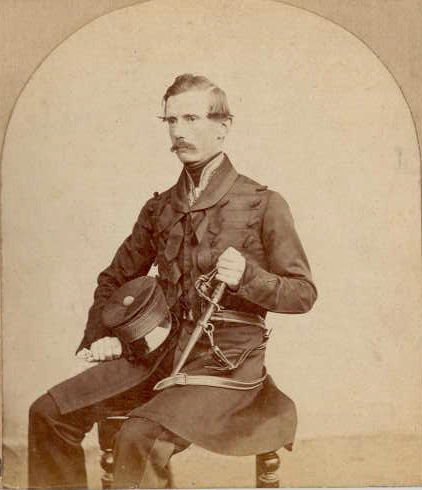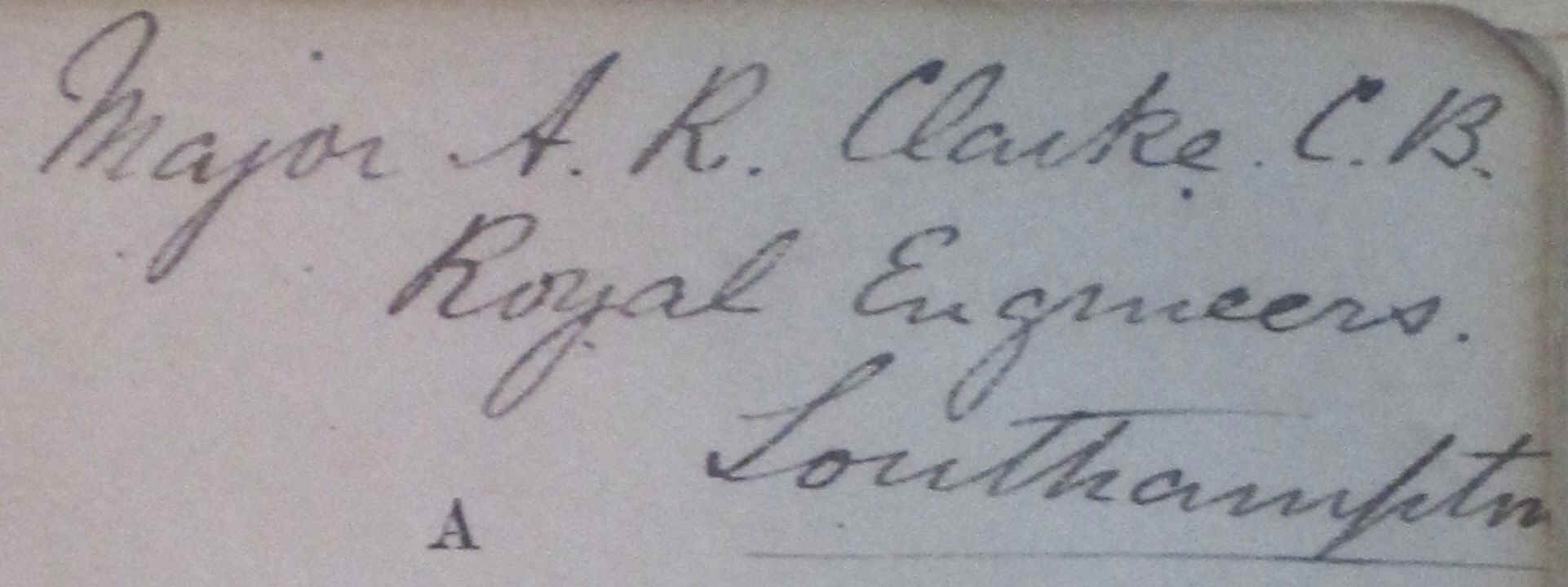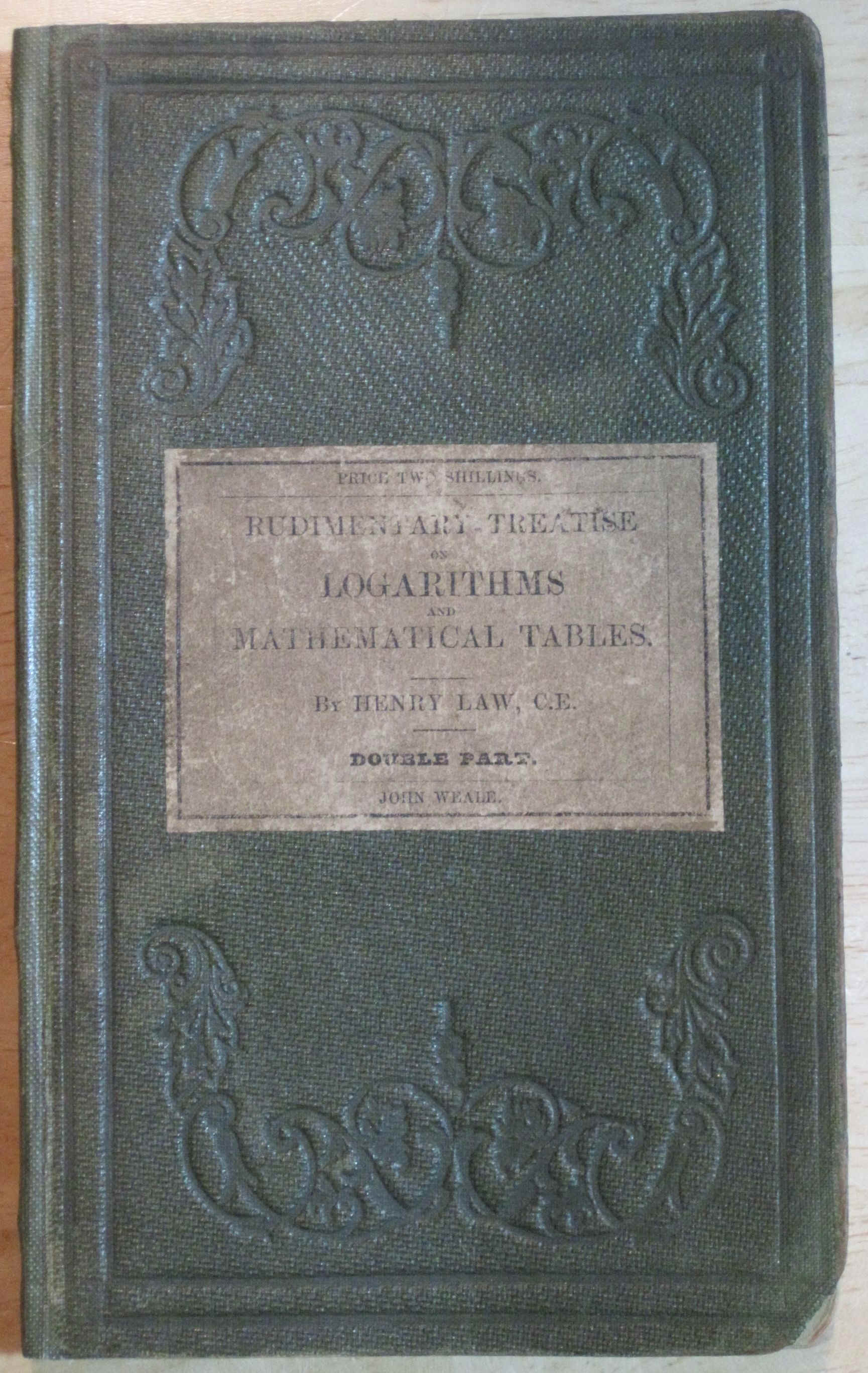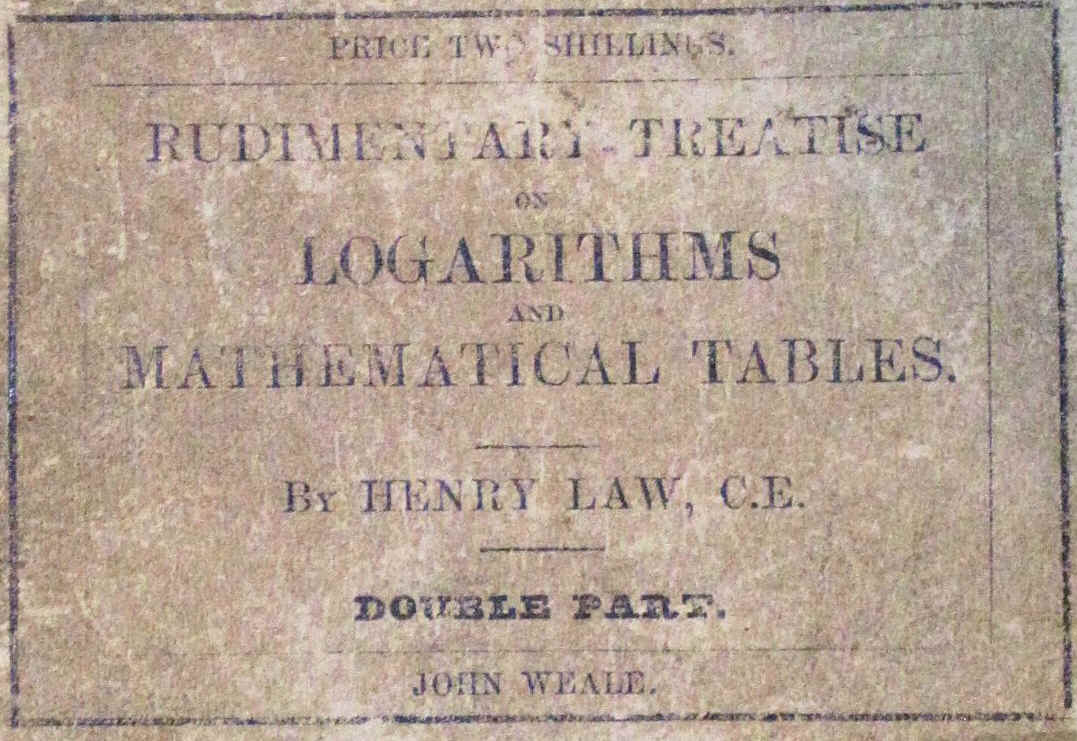
Colonel ALEXANDER ROSS CLARKE, C.B., F.R.S.,
F.R.S.E.1
Royal Engineers
by
Lieutenant Colonel (Retired) Edward De Santis
U.S. Army Corps of Engineers
© 2002. All Rights Reserved.

Captain
Alexander Ross Clarke, c. 1861
(Photograph courtesy of the Southampton Archives Services)
Author's Note: Unless otherwise indicated, the majority of the information contained in the following narrative was taken from The Life and Work of Colonel Clarke by Colonel Sir Charles Close, K.B.E., C.B., C.M.G., F.R.S. Colonel Close's memoir on the life of Alexander Ross Clarke was published in The Royal Engineers Journal, Volume XXXIX, No. 4, Chatham, Kent, December 1925, pp. 658-665. This memoir is suggested reading for anyone has wants to know more about the technical side of Clarke's life.
This research was undertaken after the author obtained a copy of a book that belonged to Colonel Clarke. The book is entitled A Rudimentary Treatise on Logarithms and Mathematical Tables by Henry Law, C.E. The book was published by John Weale of 59, High Holborn, London in 1853 and was sold to then Major Clarke by Sharland, Bookseller of the High Street in Southampton. The title page of the book bears the following inscription, presumably in Clarke’s handwriting:

Alexander Ross Clarke was born at Reading, Berkshire on the 16th of December 1828. He was the son of David Ross and Eliza Clarke. David Ross Clarke or Eriboll, Scotland had gone out to Jamaica as a merchant and in 1827 he married Eliza Hall, the daughter of Charles Hall.2
Alexander spent much of his youth with his parents in Jamaica. On leaving Jamaica the family returned to Eriboll and spent many years there, until they finally moved to London for good. After several moves in London, they settled down in 35, Devonshire Place, W. David Ross Clarke died there in 1861.
At the age of 17, Alexander suddenly formed a desire to join the Army and went up for the entrance examination for the Royal Military Academy at Woolwich after only about three weeks of preparation. The preparation time was nearly insufficient; he passed in, but was last on the list. Once at Woolwich his natural ability asserted itself. He rapidly rose in his batch and passed out first and was commissioned a 2nd Lieutenant in the Royal Engineers on the 1st of October 1847.3
After his commissioning, Clarke attended the Young Officers Course at the School of Military Engineering at Chatham, Kent. He was promoted to the rank of Lieutenant on the 11th of July 1849 and in April of 1850 he was posted to the Ordnance Survey at Southampton.4
From 1851 to 1854 Lieutenant Clarke served Canada and in 1853 Clarke married Francis Dixon, the daughter of Major General M. Dixon, R.E. Upon the completion of his tour of duty in Canada, Clarke returned to England where he was again posted to Southampton. He would serve at the Ordnance Survey in Southampton for the next 27 years. He and his family resided at 21, Carlton Crescent, Southampton, Hampshire where they lived until 1881.
Clarke was promoted to the rank of 2nd Captain on the 8th of September 1855 and in 1856 he was appointed the head of the Trigonometrical and Levelling Departments of the Ordnance Survey. He was a prolific writer and in 1858 he published The Account of the Great Triangulation, which was a history of the survey of Great Britain. In 1861 he published another work entitled The Accounts of the Levelling of England, Wales and Scotland.
Clarke was promoted to the rank of Captain on the 18th of December 1861.5 While with the Ordnance Survey in Southampton he worked as a geodesist and made calculations of the size and shape of the Earth that were the first to approximate accepted modern values with respect to both polar flattening and the equatorial radius.6
For his outstanding work in the field of surveying, Captain Clarke was elected a Fellow of the Royal Society on the 5th of June 1862.7 Soon afterwards he was also elected an Honorary Fellow of the Royal Society of Edinburgh.8
Clarke continued his research and writing and in 1863 he published The Extension of the Triangulation into France and Belgium. In 1866 he made his second determination of the size and shape of the Earth in this year.9 The figures from this determination became a standard reference for U.S. geodesy, even after acceptance of other figures. In this same year he also published a work entitled The Comparison of Standards of Length.
In 1868 Clarke was honored by being elected a Corresponding Member of the Russian Imperial Academy of Sciences, in 1870 he was made a Companion of the Most Honourable Order of the Bath (C.B.) and in 1871 he was elected an Honorary Member of the Cambridge Philosophical Society.
The civil honors bestowed upon Clarke were followed by rapid promotions in rank within the Army and the Corps of Royal Engineers. The following is a list of his promotions and dates of rank to the rank of Colonel:10
28 Aug 1871: |
Promoted Major (Army Rank). |
5 Jul 1872: |
Promoted Major (Regimental Rank). |
27 Aug 1872: |
Promoted Lieutenant Colonel. |
27 Aug 1877: |
Promoted Colonel. |
In 1880 Colonel Clarke created the term "Geodesy" when he published his famous book by that title.11 At about the same time he published articles on mathematical geography and geodesy and also wrote "The Figure of the Earth" in the Encyclopedia Britannica.
With his promotion to Colonel, Clarke might have reasonably expected to have succeeded to the next vacancy as Director of the Survey and to have served until he was retired for age. But in 1881, when he was not quite 53, an official of a familiar type woke up to the fact that Clarke had been at a home station for 27 years, and he was ordered abroad to a tropical station as the Commander Royal Engineers. Clarke was a man of somewhat hasty temper and on receipt of this order, he at once sent in his papers to retire. His retirement was approved and he was gazetted out of the Army. Immediately a storm of indignation arose in the scientific world and representations from influential quarters were made to the War Office, all to no avail. His retirement had been approved and he was required to retire. The War Office was of the opinion that a lesson must be taught those who cherished the illusion that any officer was indispensable.
Colonel Clarke retired from the Army on the 1st of October 1881 and took up residence in Redhill, Surrey. Soon after his retirement he resigned from the Royal Society for monetary reasons, as he found it difficult to pay the annual membership subscription.
In October of 1883, Clarke was appointed a British Delegate to the Geodetic Conference in Rome and in 1884 he was appointed as a British member of the International Geodetic Association. Clarke's work was considered to be so outstanding, that by 1887 he had earned for himself a European reputation in all matters connected with higher branches of mathematical and astronomical science. For his work he was awarded the Gold Medal of the Royal Society. On the occasion of the award of the medal, the London Times had this to say about Colonel Clarke:12
"The medal which, in accordance with the usual rule has been devoted to mathematics and physics, has this year been awarded to Colonel A. Clarke for his comparison of standards of length, and determination of the figure of the earth. Col. Clarke was for some 25 years the scientific and mathematical adviser for the Ordnance Survey, and while acting in that capacity he became known to the whole scientific world as possessing unique knowledge and power in dealing with the complex questions which arise in the science of geodesy. His laborious comparison of the standards of length, carried out under General Sir Henry James, R.E., are universally regarded as models of scientific precision. His determination of the ellipticity and dimensions of the earth from the great arcs of meridian and longitude involved a very high mathematical ability and an enormous amount of labour. The conclusion at which he arrived removed an apparent discrepancy between the results of pendulum experiments and those derived from geodesy, and is generally accepted as the best approximation hitherto attained as to the figure of the earth."
As an additional reward for his good work, on the 7th of June 1888 Clarke was re-elected a Fellow of the Royal Society without the necessity to pay the subscription.13 At about this same time his wife died leaving behind five daughters and three sons. Alexander Ross Clarke lived on until the 11th of February 1914 when he died at Strathmore, Reigate, Surrey. Upon his death he left behind him the reputation of having been one of the most distinguished geodesists that England ever produced, and the most eminent man of science who had ever served on the Ordnance Survey or in the Corps of Royal Engineers.
ADDENDUM
The following information was provided by the great granddaughter of Colonel Clarke, Jeanette Grant of Auckland, New Zealand. This addendum corrects some of the information presented in The Royal Engineers Journal and adds additional information regarding Colonel Clarke's family.
The Clarkes had four sons and nine daughters. Kenneth Ross Clarke died as a baby in 1873 and Mary Grace Clarke died, aged 23, in 1883. The Clarke's surviving three sons all married. The eldest son, the Reverend Alexander David Charles Mackay-Clarke (1854-1929) had no family. Willoughby Rochfort Morton Clarke (1865-1934) had two daughters. Eric Manely Clarke (1857-1932), Jeanette Grant's grandfather, went to New Zealand aboard the Albion in 1878 and married twice. He had two daughters by his first marriage and four sons by the second. He inherited some of his father's talent for mathematics and taught at Lincoln University College in New Zealand. He later changed careers and qualified as a dentist.
Of the nine daughters, only the two eldest married. It appears that after their mother died in 1888, there was no one to help them find husbands. Emma Christina Clarke married George Jacob (of the Jacobs of India) and had one daughter - Ivy Morna Jacob who married Frederick Charles Griffith of the Indian Police. Their descendants presently live in the U.K. Emma died in 1885. Marcia Annie Alexandra Clarke married the Reverend Frederick Lihou de Carteret and had three children.
In addition to his outstanding surveying and geodetic work, Colonel Clarke appears to have been a remarkable person. In a letter to Jeanette Grant's grandfather, Colonel Clarke's eldest son wrote the following:-
"There was no illness with him; only the natural result of old age. He had been growing feeble in mind and body for some time past but resigned himself to the inevitable and with great patience and cheerfulness. His life, always beautiful, was abundantly so at the end . . . he always had an objection to black and we avoided it as much as possible. How can one associate gloom with the passing of such a radiant Saint to be forever with the Lord? Almost the last words he said to me was to quote some friend who had said to him "Hallelujah! I am on the road to glory." Didn't I think that a lovely thing to say?
ACKNOWLEDGEMENT
The author is indebted to Michael (Mick) Fines who so generously donated the copy of the book A Rudimentary Treatise on Logarithms and Mathematical Tables that was owned by Colonel Clarke. This book has found a good home in the author's collection of militaria of The Corps of Royal Engineers. Mick was himself a Sapper (Army Number 22286552). He enlisted in the Royal Engineers (Regular Army) at Sheffield on the 23rd of July 1949 as a Surveyor's Assistant for a period of 5 years with the Colours and 7 years in the Reserve. Following his recruit training near Great Malvern, he was posted to the School of Military Survey near the village of Hermitage in Berkshire. There he qualified as a Trigonometric Surveyor and was subsequently posted to a unit in London. While in that unit he performed survey duties in the field at many locations in the United Kingdom.



Colonel Clarke's
Book
The Book Title
Label
The Title Page with Clarke's Name
Mick returned to the School of Military Survey and qualified as a Cartographic Photographer. He subsequently married and applied for discharge to the Army Reserve in 1951. He was released to the Army Reserve on the 14th of September 1951.14
NOTE: Detailed information regarding the survey work of Colonel Clarke may be found at https://en.wikipedia.org/wiki/Alexander_Ross_Clarke.
REFERENCES:
ENDNOTES
1. Fellow of the Royal Society (F.R.S.) and
Fellow of the Royal Society of Edinburgh (F.R.S.E.).
2. BLACK, A. & C., p. 139.
3. CONNOLLY, T.W.J., p. 31.
4. Ibid.
5. Ibid.
6. Encyclopedia Britannica.
7. The Royal Society Internet Website.
8. BLACK, A. & C., p. 139.
9. Encyclopedia Britannica.
10. CONNOLLY, T.W.J., p. 31.
11. SANDES, E.W.C., pp. 191, 207 and 217.
12. PORTER, W. pp. 247-248.
13. The Royal Society Internet Website.
14. FINES, M. Army Pay Book.